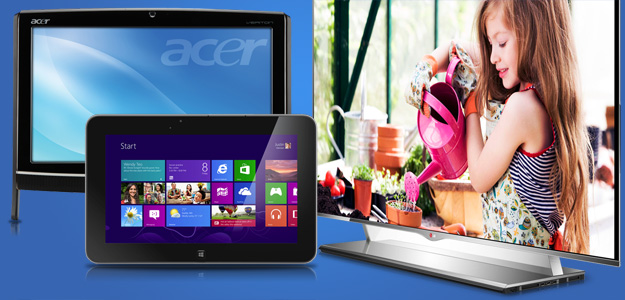 It looks like CES will be rather exciting this year: We’re going to witness the first battle in what will likely be an epic war. No longer content to let Apple push them around, Google, Samsung, Lenovo, LG, RIM, Dell, and others are stepping up their game this year in an attempt to seize dominance. While many of these battles will take place after CES, and not all of the CES battles will involve Apple (particularly since Apple doesn’t go to CES), the initial fights will be fascinating nonetheless.
It looks like CES will be rather exciting this year: We’re going to witness the first battle in what will likely be an epic war. No longer content to let Apple push them around, Google, Samsung, Lenovo, LG, RIM, Dell, and others are stepping up their game this year in an attempt to seize dominance. While many of these battles will take place after CES, and not all of the CES battles will involve Apple (particularly since Apple doesn’t go to CES), the initial fights will be fascinating nonetheless.
Let’s cover some of the big ones.
4K, OLED and connected TVs
The battle for your living room will get off to a heady start as LG and Samsung fight it out over who can have the first large-screen OLED TV you can actually afford. LG already fired the first shot with a 55-inch model, but priced at more than $10,000, I doubt it will win if Samsung can bring out one that is more affordable. I have my doubts whether OLED will stick this year – the technology has historically not only been very expensive, it has had a service life measured in months. But 4K TVs, or Ultra High Definition TVs, will both be affordable and very prevalent. 3D TVs didn’t really take largely because of a lack of compelling content and the annoying glasses, but 4K is easy to upscale from HD, which should ensure these TVs, at about four times the resolution of HD, will be far more useful. While not as beautiful as OLED, they are none-the-less pretty impressive, and a good portion of the show will be taken up with them.
Smart TVs will also continue to play a role, though I think we’ll still be waiting for Apple or Intel to get the content deals needed to make this a more powerful feature. You will note that the interfaces have improved a great deal over the last year.
Big honking Windows tablets
You’ll see a number of these tablets – more like portable all-in-one TVs – at the show. Sony and Dell have already announced theirs, and there will be even more to come from competitors. Think of these more like you would digital game boards than oversized iPads, in terms of how you would use them. They will be for group gaming, or to move streaming content around the home or on vacation. I think they’ll also be handy for dorms because of their portability for collaborative projects, and for shared streaming movie viewing. That’s not to mention how enticing they’ll be for folks who really want to have a big-screen in-car experience as well. They do have batteries, but battery life is limited, and while a lot lighter than those old CRT-based portable TVs, they clearly aren’t iPad light. Gaming will be their big advantage, and if successful, they could revitalize board games with animation and create a new class of interactive video games.
Windows 8 touch PCs
Due to a massive touchscreen shortage in 2013, a number of planned products using Intel’s Atom processor never made it to the market in 2012. But they won’t miss CES, so expect to be up to your armpits in super-light, super-thin, and relatively (for Intel) inexpensive Windows 8 tablets competing with even more of their Windows RT counterparts. Screen sizes should run from 30 inches down to 7 inches if industry rumors are to be believed, and this will be the broadest range of PCs in the history of the market. After seeing the variety, I think we’ll conclude the days of every manufacturer pretty much building the same off-white box are long dead and gone. Size, color, battery life and other aspects will be all over the map.
Car wars
CES will mark the beginning of a massive race to see which car manufacturer can take the lead for in-car entertainment from Ford. The Japanese, Koreans, Italians, and General Motors will be showcasing technology at the show, and Ford clearly recognizes that it has some important turf to protect here, so its engineers haven’t been sleeping either. All the major players have hired people from CE companies like Apple to help them in their efforts, thanks to the overwhelming success of Ford’s Sync efforts. I love going into the car segment of the show because there are so many crazy cars there, and you can typically find me by following the drool trail I leave when I first enter that pavilion.
Make way for China
One of the bigger trends I’m expecting this year is an invasion of Chinese CE vendors. China wants into this market with a passion and, from what I understand, its manufacturers are making CES 2013 a beachhead. Historically, China has been hobbled by illegal copies of other products and a tendency to ship cheap junk, but the country has improved sharply over the years. In fact, much of what we currently buy in this segment is already made in China, it’s just not sold under Chinese brands. Chinese vendors are going to make a big push to change that last part this year, but few seem to know how to do it correctly. Much like the Japanese and Koreans before them, they’ll likely find this an expensive lesson to learn.
Overall, this should be an impressive show, though I expect most of the truly compelling new products won’t show up until around mid-year for the fourth-quarter push. This means, that no matter how good the products of CES 2013 are, they will likely be eclipsed in six months. Isn’t the technology market wonderful?
Guest contributor Rob Enderle is the founder and principal analyst for the Enderle Group, and one of the most frequently quoted tech pundits in the world. Opinion pieces denote the opinions of the author, and do not necessarily represent the views of Digital Trends.


